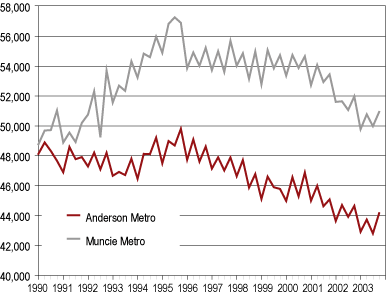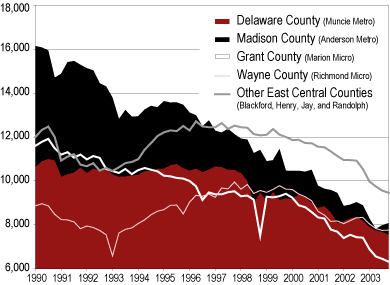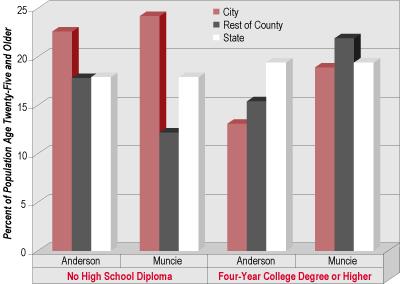Anderson and Muncie
Bureau of Business Research, Ball State University, Muncie
The last decade has not produced good economic results for Anderson and Muncie. Like most of Indiana, both of these regions failed to keep pace with national growth beginning in the mid-1990s and continuing through the most recent recession; but these counties suffered a performance gap that was especially severe. NAICS-based employment and earnings records from the Quarterly Census of Employment and Wages (formerly known as ES-202 data) were made available in October that allow us to track economies back to 1990. What they show us in east central Indiana is not very pretty.
There has been a general downward trend in payroll employment of business establishments in Delaware County (the Muncie metro area) and Madison County (the Anderson metro area) since the mid-point of the last decade, as depicted in Figure 1. For the Muncie economy, the downturn came on the heels of a period of very strong net hiring in the first half of the decade. Yet the long duration of the job slump, together with an increased rate of job loss during the recent recession, have brought employment totals down to just a fraction above where they stood in 1990.
Figure 1
Metro Area Employment Since 1990

Anderson’s downturn was even more severe. Its growth in the first half of the 1990s was much less pronounced, and the pace of its job loss during the latter half was more severe. As a result, Madison County firms employed about 4,300 fewer workers in 2003 than were on payrolls in 1990, a contraction of 9 percent.
The losses were especially large in manufacturing. In 1996, there were 9,000 workers employed in just one manufacturing industry—transportation equipment—in Madison County. In 2003, that same industry employed just 4,500 workers. That mirrors the slide in total manufacturing employment in Anderson, shown in Figure 2, which fell from 16,000 workers in 1990 to just half of that total fourteen years later.
Figure 2
Manufacturing Employment Since 1990

The experience of Muncie’s manufacturing sector was only slightly better. After hovering between 10,000 and 11,000 workers until 1997, the closings and setbacks of that year precipitated a pattern of decline that has continued to the present. In 2003, Delaware County manufacturing payrolls dipped below 8,000 jobs for the first time.
Establishment survey data (CES) is available for the Muncie metro only (due to its MSA status) and show this decline continuing through 2004. The most recent numbers put October 2004 manufacturing employment at just 6,700 jobs, down 11 percent from 2003.
Causes and Consequences of the Economic Declines
It is difficult to know with certainty what these disappointing results can be attributed to. Although Anderson and Muncie’s manufacturing job losses were among the worst in the state, they took place in a period when almost 20 percent of factory jobs were eliminated nationwide. Despite this, in the national economy, there was significant job growth.
Thus, the search for answers to the problems that have challenged the Anderson and Muncie economies over the past ten years should seek not only to understand why manufacturing jobs have declined, but also why there were not enough nonmanufacturing jobs created to replace them.
A glance at the population profiles produced by the 2000 Census provides some insights. The educational profile of the adult population in both Anderson and Muncie reflects the lower educational requirements of a traditional manufacturing base (see Figure 3). Within their respective city limits, more than one out of every five adults in Anderson and Muncie do not have a high school diploma.
Figure 3
Educational Attainment in Muncie and Anderson, Census 2000

At the other end of the spectrum, Madison County has fewer college graduates than the state average, and Delaware County has fewer than what one would expect since it is home to a large university. Given the emphasis on training and education in the higher-paying service industries, labor force development will be a key part of future economic success.
The Outlook for 2005
The rebound of manufacturing in the national economy through the first three quarters of 2004 gives some hope that the declines in factory employment suffered by Anderson and Muncie will soon come to an end. The decline of the dollar, the surge in corporate profits, and the revival of business spending at least provide an environment in which a reversal of these unfortunate trends can take place.
But three years beyond the official end point of the 2001 recession, no positive sign of an end to that decline has been reached. Until the economic base of these two counties transforms itself to take better advantage of growth opportunities outside of manufacturing, the most likely outcome is a continued decline in the coming year.
Also in this Issue…



